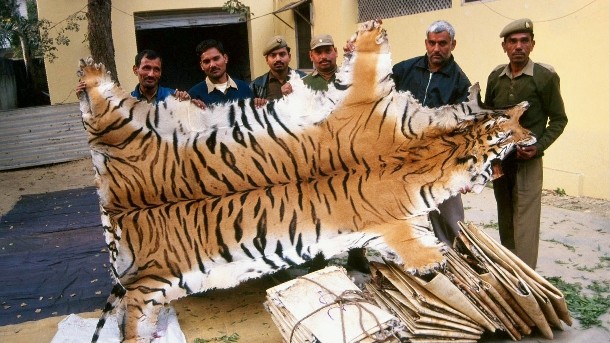STATUS: Endangered
POPULATION: Around 3,890
SCIENTIFIC NAME: Panthera tigris
WEIGHT: 220–660 pounds
LENGTH: 6–10 feet
HABITATS: Tropical rainforests, evergreen forests, temperate forests, mangrove swamps, grasslands and savannas

After a century of decline, tiger numbers are on the rise. At least 3,890 tigers remain in the wild, but much more work is needed to protect this species that’s still vulnerable to extinction.
The largest of all the Asian big cats, tigers rely primarily on sight and sound rather than smell for hunting. They typically hunt alone and stalk prey. A tiger can consume up to 88 pounds of meat at one time. On average, tigers give birth to two to four cubs every two years. If all the cubs in one litter die, a second litter may be produced within five months.
Tigers generally gain independence at two years of age and attain sexual maturity at age three or four for females and at four or five years for males. Juvenile mortality is high however—about half of all cubs do not survive more than two years. Tigers have been known to reach up to 20 years of age in the wild.
Males of the largest subspecies, the Amur (Siberian) tiger, may weigh up to 660 pounds. For males of the smallest subspecies—the Sumatran tiger—upper range is at around 310 pounds. Within each subspecies, males are heavier than females.
Tigers are mostly solitary, apart from associations between mother and offspring. Individual tigers have a large territory, and the size is determined mostly by the availability of prey. Individuals mark their domain with urine, feces, rakes, scrapes and vocalizing.
Across their range, tigers face unrelenting pressures from poaching, retaliatory killings and habitat loss. They are forced to compete for space with dense and often growing human populations.
This big cat is both admired and feared by people around the world. If forests are emptied of every last tiger, all that will remain are distant legends and zoo sightings.


The tiger has evolved over thousands of years. Currently, this big cat is being trapped, skinned and pushed out of its home. Those left in the wild cling to survival in a few patches of forest scattered across Asia.
To save tigers, we need to protect the forest habitats across Asia where they live. By saving biologically diverse places, we allow tigers to roam and preserve the many other endangered species that live there. In order to protect just one tiger, we have to conserve around 25,000 acres of forest.
As a large predator, the tiger plays a key role in maintaining healthy ecosystems. These ecosystems supply both nature and people with fresh water, food, and health—which means that by saving tigers, we are helping people too.
Tigers can directly help some of the world’s poorest communities. Where tigers exist, tourists go. And where tourists go, money can be made by communities with few alternatives for income. Tiger conservation projects also help provide alternative livelihoods for rural communities that are not only more sustainable, but can raise income levels too.
HABITAT LOSS
Tigers have lost 93% of their historical range. Their habitat has been destroyed, degraded and fragmented by human activities. The clearing of forests for agriculture and timber, as well as the building of road networks and other development activities, pose serious threats to tiger habitats. Tigers need wide swaths of habitat for their survival since they are very territorial. Fewer tigers can survive in small, scattered islands of habitat, which leads to a higher risk of inbreeding and makes tigers more vulnerable to poaching as they venture beyond protected areas to establish their own territories.HUMAN WILDLIFE CONFLICT
People and tigers increasingly compete for space. As forests shrink and prey gets scarce, tigers are forced to disperse beyond protected areas in search of their own territories. This takes them into human-dominated areas that lie between habitat fragments, where they hunt domestic livestock that many local communities depend on for their livelihood. In retaliation, tigers are killed or captured. “Conflict” tigers are known to end up for sale in black markets. Local community dependence on forests for fuelwood, food and timber heightens the risk of tiger attacks on people.EFFECTS OF CLIMATE CHANGE
One of the world’s largest, and most uniquely-adapted, tiger populations is found in the Sundarbans—a large mangrove forest area shared by India and Bangladesh on the northern coast of the Indian Ocean. These mangrove forests harbor a variety of species, including tigers, and protect coastal regions from storm surges and wind damage. However, rising sea levels caused by climate change threaten to wipe out these forests and the last remaining habitat of this tiger population. According to a WWF study, without mitigation efforts, projected sea level rise—about a foot by 2070—could destroy nearly the entire Sundarbans tiger habitat.
CAPTIVE TIGERS
There are an estimated 5,000 tigers living in captivity in the United States; more than all wild tiger populations across Asia. Almost 95 percent of captive tigers are privately owned, often by people not trained to care for them. Many of these individual owners and non-accredited zoos offer photo opportunities or “selfies” with tigers. These photo opportunities create demand for a constant supply of tiger cubs, and tigers who are too large or unsafe to sit in for these photos become a liability. While most of these animals are bred in the United States and not taken from the wild, the lack of regulation around this large population of animals leaves them susceptible to the illegal tiger trade.POACHING AND ILLEGAL WILDLIFE TRADE
Poaching is the most immediate threat to wild tigers. Every part of the tiger—from whisker to tail—is traded in illegal wildlife markets. In relentless demand, their parts are used for traditional medicine, folk remedies and, increasingly, as status symbols among some Asian cultures.
There are usually limited resources for guarding protected areas in the countries where tigers live. Even countries with strong enforcement of tiger protection laws fight a never-ending battle against poaching, which is now often orchestrated by transnational crime syndicates that rake in significant profits from wildlife crime. In Indochina and China, poaching is so pervasive that thousands of forest acres stand empty of tigers.
The impact from the death of a single tiger at the hands of poachers reaches beyond one single loss. If a female tiger with cubs is killed, her cubs will most likely die without their mother, and the female's potential for future breeding is lost. If a male is killed, his death can result in intensive competition for his territory among surviving males in the population, leading to potential injury and death.
We can save wild tigers. In 2010, the 13 tiger range countries committed to TX2—to double wild tiger numbers by 2022, the next Year of the Tiger.